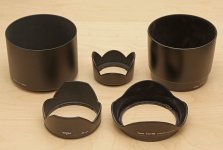I come from photography. In the field of cinema and professional photography,
it is forbidden opening the shutter before having positioned the appropriate hoods on the lens. It seems that this natural and logical system, which rightly follows the laws of optical physics, is totally ignored by both producers and users of binoculars.
At the beginning of the last century, binoculars were often equipped with removable lens hoods. Even today, only a few super astronomical or long-range binoculars, have the hoods. In the panorama of aiming optics, on the other hand, each model has optional hoods and various ARDs.
https://i.ebayimg.com/images/g/qPkAAOSwOFFduZjL/s-l1600.jpg
2 or 3 mm of lens hood does not make the difference (a length at least equal to the diameter of the lens will be needed).
The Nikon with its 30mm Monarch7 did a flop, with side flares. And not even the use of a suitable lens hood could solve the situation.
But many binoculars with these defects, can be solved perfectly with just the
shadow of the hand or the
visor of a hat as a lens hood. And therefore, to deprive yourself of an excellent instrument that has some flares, is in my opinion an
anti-logical procedure.
How many times have I read about people who gave up fantastic binoculars, for this problem that can often be solved with little.





